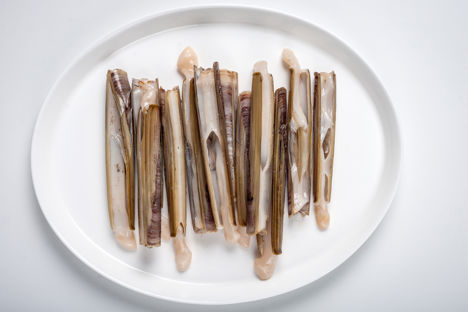Razor clams are strange creatures - technically bivalves like regular clams and mussels, their fine white flesh resembles squid more than some of its closer relatives. They live burrowed in the sand on sheltered beaches, and at low tide you may be able to spot the ‘keyhole’ openings to their burrows. Catching razor clams is a popular pastime in some areas, simply sprinkling some salt into their burrows can see them wriggling to the surface into the clutches of hungry foragers.
What to look for when buying razor clams
Make sure razor clams are alive and fresh - obviously if you forage them yourself you will be able to ensure this! Often found tied in bundles in shops, they have a tendency to droop out of their shell slightly - give the white fleshy part a poke, it should wriggle back inside the shell. Do not keep razor clams submerged in fresh water, as they will drown - if you need to store them overnight, wrap them in a damp cloth and keep in the bottom drawer of the fridge. Razor clams that seem very heavy are likely to be full of sand, so avoid buying these.
The MCS recommends avoiding razor clams below 10cm in length, and do not forage or buy foraged clams from May to September.
How to cook razor clams
It is necessary to properly clean and prepare razor clams before cooking. This takes some time, as each razor clam needs to be checked individually. Check the clams are closed - any open shells should close when gently tapped - if they don’t, you should bin them. Place all the clams in a colander and continually run cold water over them to remove excess sand. Check the outside of the shells to make sure they aren’t broken; any damaged shells should be discarded.
The classic method for cooking razor clams is by steaming them in a flavoured liquid, perhaps with a splash of wine and some sweated onions and garlic, though there are all kinds of methods that flatter their sweet, delicate meat. Don’t forget to remove the ‘foot’ of the clam before eating, and to cut out the central dark intestinal tract, leaving only the firm white clam meat. Make sure you don’t overcook the clams, as they can become tough quite quickly.
What goes with razor clams
Razor clams’ sweet, delicate meat matches up to a wide variety of flavours. Adam Byatt uses chilli with gratinated Parmesan and breadcrumbs to add texture and heat to a classic preparation of aromatic vegetables and wine in his recipe.
Adam Stokes serves his razor clams diced and prettily presented in the shell with delicate pairings of spring onion and almond, but for a meatier approach, try Nathan Outlaw’s recipe of Ling and razor clams with bacon, samphire and seaweed.
Pastis is also a classic and aromatic accompaniment - try Morgan Meunier’s recipe of Sea bass, asparagus with pastis and saffron sauce for a great spring dish.
Get in touch
Please sign in or register to send a comment to Great British Chefs.



